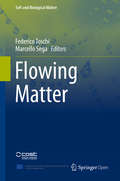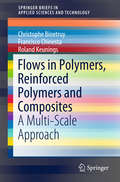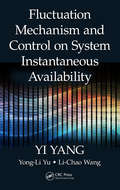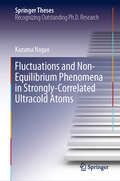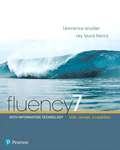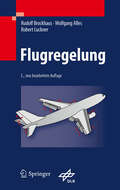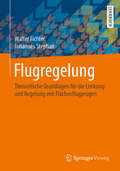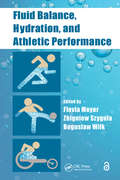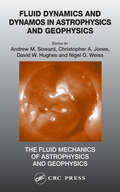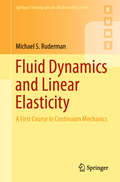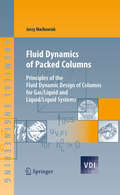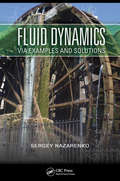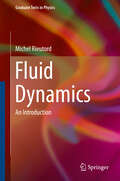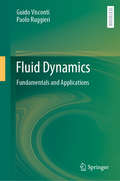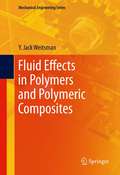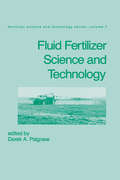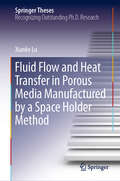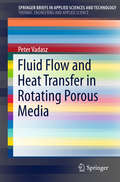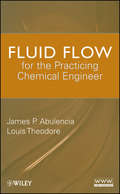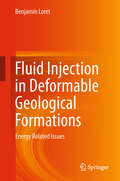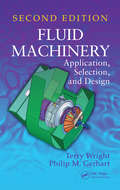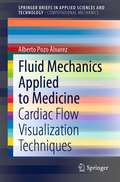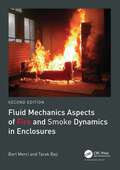- Table View
- List View
Flowing Matter (Soft and Biological Matter)
by Federico Toschi Marcello SegaThis open access book, published in the Soft and Biological Matter series, presents an introduction to selected research topics in the broad field of flowing matter, including the dynamics of fluids with a complex internal structure -from nematic fluids to soft glasses- as well as active matter and turbulent phenomena. Flowing matter is a subject at the crossroads between physics, mathematics, chemistry, engineering, biology and earth sciences, and relies on a multidisciplinary approach to describe the emergence of the macroscopic behaviours in a system from the coordinated dynamics of its microscopic constituents. Depending on the microscopic interactions, an assembly of molecules or of mesoscopic particles can flow like a simple Newtonian fluid, deform elastically like a solid or behave in a complex manner. When the internal constituents are active, as for biological entities, one generally observes complex large-scale collective motions. Phenomenology is further complicated by the invariable tendency of fluids to display chaos at the large scales or when stirred strongly enough. This volume presents several research topics that address these phenomena encompassing the traditional micro-, meso-, and macro-scales descriptions, and contributes to our understanding of the fundamentals of flowing matter. This book is the legacy of the COST Action MP1305 “Flowing Matter”.
Flows in Polymers, Reinforced Polymers and Composites
by Francisco Chinesta Roland Keunings Christophe BinetruyThis book gives a detailed and practical introduction to complex flows of polymers and reinforced polymers as well as the flow of simple fluids in complex microstructures. Over the last decades, an increasing number of functional and structural parts, made so far with metals, has been progressively reengineered by replacing metallic materials by polymers, reinforced polymers and composites. The motivation for this substitution may be the weight reduction, the simpler, cheaper or faster forming process, or the ability to exploit additional functionalities. The present Brief surveys modern developments related to the multi-scale modeling and simulation of polymers, reinforced polymers, that involve a flowing microstructure and continuous fiber-reinforced composites, wherein the fluid flows inside a nearly stationary multi-scale microstructure. These developments concern both multi-scale modeling, defining bridges between the micro and macro scales - with special emphasis on the mesoscopic scale at which kinetic theory descriptions apply and advanced simulation techniques able to address efficiently the ever more complex and detailed models defined at different scales. This book is addressed to students (Master and doctoral levels), researchers and professionals interested in computational rheology and material forming processes involving polymers, reinforced polymers and composites. It provides a unique coverage of the state of the art in these multi-disciplinary fields.
Flucht- und Rettungswege: Anforderungen behinderter Menschen an die Bewältigung von Notfällen
by Adam MerschbacherDieses Fachbuch erklärt die Planung, den Bau und erläutert die Vorschriften für Flucht- und Rettungswege. Dabei werden die Zuständigkeiten und Verantwortungen geklärt und welche Gesetze, Verordnungen und Regelungen es gibt. Besonderer Schwerpunkt dieses Buches sind dabei die Anforderungen behinderter Menschen an die Bewältigung von Notfällen, wie Rollstuhlfahrer, Rollator Nutzer und gehbehinderte Menschen, blinde und hochgradig sehbehinderte Menschen, schwerhörige, gehörlose und ertaubte Menschen, Menschen mit Einschränkungen der sprach und/oder Sprachvermögens, Menschen mit Einschränkungen der Oberkörperfunktion und bettlägerige Menschen.
Fluctuation Mechanism and Control on System Instantaneous Availability
by Yi Yang Yong-Li Yu Li-Chao WangFluctuation Mechanism and Control on System Instantaneous Availability facilitates the development of modeling and identification skills for both theoretical research and applications. Supplying an overall summary of current research results in fluctuation analysis of instantaneous availability, it covers the theory, methodology, and specific engineering implementation required to conduct equipment instantaneous availability analysis. Presenting practical methods and tools, it describes how to control the matching transition of new equipment systems as a result of interactions among sub-systems.
Fluctuation-Induced Network Control and Learning: Applying the Yuragi Principle of Brain and Biological Systems
by Masayuki Murata Kenji LeibnitzFrom theory to application, this book presents research on biologically and brain-inspired networking and machine learning based on Yuragi, which is the Japanese term describing the noise or fluctuations that are inherently used to control the dynamics of a system. The Yuragi mechanism can be found in various biological contexts, such as in gene expression dynamics, molecular motors in muscles, or the visual recognition process in the brain. Unlike conventional network protocols that are usually designed to operate under controlled conditions with a predefined set of rules, the probabilistic behavior of Yuragi-based control permits the system to adapt to unknown situations in a distributed and self-organized manner leading to a higher scalability and robustness.The book consists of two parts. Part 1 provides in four chapters an introduction to the biological background of the Yuragi concept as well as how these are applied to networking problems. Part 2 provides additional contributions that extend the original Yuragi concept to a Bayesian attractor model from human perceptual decision making. In the six chapters of the second part, applications to various fields in information network control and artificial intelligence are presented, ranging from virtual network reconfigurations, a software-defined Internet of Things, and low-power wide-area networks.This book will benefit those working in the fields of information networks, distributed systems, and machine learning who seek new design mechanisms for controlling large-scale dynamically changing systems.
Fluctuations and Non-Equilibrium Phenomena in Strongly-Correlated Ultracold Atoms (Springer Theses)
by Kazuma NagaoThis book discusses non-equilibrium quantum many-body dynamics, recently explored in an analog quantum simulator of strongly correlated ultracold atoms. The first part presents a field-theoretical analysis of the experimental observability of the Higgs amplitude mode that emerges as a relativistic collective excitation near a quantum phase transition of superfluid Bose gases in an optical lattice potential. The author presents the dynamical susceptibilities to external driving of the microscopic parameters, taking into account a leading-order perturbative correction from quantum and thermal fluctuations and shows clear signatures of the Higgs mode in these observables. This is the first result that strongly supports the stability of the Higgs mode in three-dimensional optical lattices even in the presence of a spatially inhomogeneous confinement potential and paves the way for desktop observations of the Higgs mode. In the second part, the author applies the semi-classical truncated-Wigner approximation (TWA) to far-from-equilibrium quantum dynamics. Specifically, he considers the recent experiments on quantum-quench dynamics in a Bose-Hubbard quantum simulator. A direct comparison shows remarkable agreement between the numerical results from TWA and the experimental data. This result clearly indicates the potential of such a semi-classical approach in reliably simulating many-body systems using classical computers. The book also includes several chapters providing comprehensive reviews of the recent studies on cold-atomic quantum simulation and various theoretical methods, including the Schwinger-boson approach in strongly correlated systems and the phase-space semi-classical method for far-from-equilibrium quantum dynamics. These chapters are highly recommended to students and young researchers who are interested in semi-classical approaches in non-equilibrium quantum dynamics.
Fluency with Information Technology: Skills, Concepts, and Capabilities
by Ray Henry Lawrence Snyder<p>Having grown up with computers, most readers already know how to use Information Technology (IT) in their daily lives--but use is not understanding. More than ever, they must become "computational thinkers," able to conceptualize where and how computation can be used effectively. <p>Equipping readers with a deeper understanding of the broad capabilities of technology, Fluency with Information Technology, 7th Edition uses a project-oriented learning approach supported by examples and realistic problem-solving scenarios. Authors Larry Snyder and Ray Henry teach readers to navigate IT independently and become effective users of today's resources, forming a foundation of skills they can adapt to their personal and career goals as future technologies emerge. The text's approach is centered on three types of content--skills, concepts, and capabilities--that prepare readers to adapt to an ever-changing computing environment. This 7th Edition incorporates updates and new content that mirrors the way contemporary readers encounter technology in their lives.</p>
Flugregelung
by Wolfgang Alles Rudolf Brockhaus Robert LucknerDas Buch liefert die Grundlagen für den Vorentwurf von Flugregelungssystemen. Der systematische Aufbau führt Leser von einfachen Strukturen für Dämpfer, Autostabilisatoren und Lageregler hin zu komplexen Gesamtsystemen (Automatic Flight Control System).
Flugregelung: Theoretische Grundlagen für die Lenkung und Regelung von Flächenflugzeugen
by Johannes Stephan Walter FichterDieses Buch beschreibt alle notwendigen Algorithmen, die die Lenkung und Regelung von Flächenflugzeugen bis hin zum vollautomatischen Flug ermöglichen. Für jede funktionale Komponente wird eine moderne und praktikable Herangehensweise vorgestellt. Als Voraussetzung benötigt der Leser lediglich wenige Vorkenntnisse, die sich vorwiegend auf lineare Systembeschreibungen im Zustandsraum beschränken. Dadurch ist der mathematische Zugang einfach möglich. Ein praxisnahes Beispiel zeigt die praktische Verwertbarkeit der dargestellten Verfahren.
Fluid Balance, Hydration, and Athletic Performance
by Flavia MeyerAthletes and nonathletes frequently consume too little water or fluids, affecting exercise performance as well as overall health. This book comprehensively reviews the aspects relating to body fluid balance, rehydration, and physical exercise. It provides background on body water balance and turnover, topics related to electrolyte balance, and sweating as the basis for thermoregulatory and fluid homeostasis during exercise. In addition, chapters cover body water balance evaluation and regulation; cardiovascular and metabolic responses to fluid imbalance; effects of dehydration on aerobic power, muscle strength, and cognitive function; fluid intake timing; and optimal beverage selection.
Fluid Dynamics and Dynamos in Astrophysics and Geophysics (The Fluid Mechanics of Astrophysics and Geophysics)
by Christopher A. Jones David W. Hughes Andrew M. Soward Nigel O. WeissThe increasing power of computer resources along with great improvements in observational data in recent years have led to some remarkable and rapid advances in astrophysical fluid dynamics. The subject spans three distinct but overlapping communities whose interests focus on (1) accretion discs and high-energy astrophysics; (2) solar, stellar, and
Fluid Dynamics and Linear Elasticity: A First Course in Continuum Mechanics (Springer Undergraduate Mathematics Series)
by Michael S. RudermanThis book provides a concise introduction to continuum mechanics, with a particular emphasis on fluid dynamics, suitable for upper undergraduate students in applied mathematics and related subjects.Starting with a preliminary chapter on tensors, the main topic of the book begins in earnest with the chapters on continuum kinematics and dynamics. Following chapters cover linear elasticity and both incompressible and compressible fluids. Special topics of note include nonlinear acoustics and the theory of motion of viscous thermal conducting compressible fluids.Based on an undergraduate course taught for over a decade, this textbook assumes only familiarity with multivariate calculus and linear algebra. It includes many exercises with solutions and can serve as textbook for lecture courses at the undergraduate and masters level.
Fluid Dynamics of Packed Columns
by Claudia Hall Jerzy MackowiakThis book provides support to engineers as well as graduate students in their daily design work within the industry or for the development of new plants. It investigates the key issues relating to the fluid dynamic design of packed columns used in rectification, absorption and stripping (desorption) under vacuum, normal pressure and up to 100 bar and liquid-liquid-extraction, which are relevant in waste air and wastewater technology. The author presents a standardised model, which is valid for any type of packing and can be used to calculate the gas velocity at flooding point as well as the liquid hold-up and the pressure drop throughout the entire operating range for random packings, stacked packings elements, tube columns and structured packings with different flow channel angles. The book also contains packing parameter data for approx. 200 random and structured packings. In addition to outlining the fundamental principles of fluid dynamics, it presents numerous examples of practical application.
Fluid Dynamics via Examples and Solutions
by Sergey NazarenkoFluid Dynamics via Examples and Solutions provides a substantial set of example problems and detailed model solutions covering various phenomena and effects in fluids. The book is ideal as a supplement or exam review for undergraduate and graduate courses in fluid dynamics, continuum mechanics, turbulence, ocean and atmospheric sciences, and relate
Fluid Dynamics: An Introduction (Graduate Texts in Physics)
by Michel RieutordThis book is dedicated to readers who want to learn fluid dynamics from the beginning. It assumes a basic level of mathematics knowledge that would correspond to that of most second-year undergraduate physics students and examines fluid dynamics from a physicist’s perspective. As such, the examples used primarily come from our environment on Earth and, where possible, from astrophysics. The text is arranged in a progressive and educational format, aimed at leading readers from the simplest basics to more complex matters like turbulence and magnetohydrodynamics. Exercises at the end of each chapter help readers to test their understanding of the subject (solutions are provided at the end of the book), and a special chapter is devoted to introducing selected aspects of mathematics that beginners may not be familiar with, so as to make the book self-contained.
Fluid Dynamics: Fundamentals and Applications
by Guido Visconti Paolo RuggieriThis introductory book addresses a broad range of classical Fluid Dynamics topics, interesting applications, and related problems in everyday life. The geophysical and astrophysical applications discussed concern e.g. the shape and internal structure of the Earth and stars, the dynamics of the atmosphere and ocean, hydrodynamic instabilities, and the different kinds of waves that can be found in the atmosphere, ocean and solid Earth. Non-linear waves (solitons) are also mentioned. In turn, the book explores problems from everyday life, including the motion of golf balls, life at low Reynolds numbers, the physics of sailing, and the aerodynamics of airplanes and Grand Prix cars. No book on this topic would be complete without a look at chaos and turbulence; here the problems span from Gaussian plumes to chaotic dynamos, to stochastic climate modeling. Advances in fluid dynamics have produced a wealth of numerical methods and techniques, which are used in many of the applications. Given its structure, the book can be used both for an introductory course to fluid dynamics and as preparation for more advanced problems typical of graduate-level courses.
Fluid Effects in Polymers and Polymeric Composites
by Y. Jack WeitsmanFluid Effects in Polymers and Polymeric Composites, written by the late Dr. Y. Jack Weitsman, addresses the wide range of parameters that affect the interaction of fluids with polymers and polymeric composites. The book aims at broadening the scope of available data, mostly limited up to this time to weight-gain recordings of fluid ingress into polymers and composites, to the practical circumstances of fluctuating exposure. Various forms of experimental data are given, in conjunction with theoretical models derived from basic scientific principles, and correlated with severity of exposure conditions and interpreted by means of rationally based theoretical models. The practical implications of the effects of fluids are discussed. The issue of fluid effects on polymers and polymeric composites is of concern to engineers and scientists active in aerospace and naval structures, as an increasing portion of these structures are made of polymeric composites and employ polymeric adhesives as a joining device. While the book is intended for this audience, it will also interest researchers and graduate students interested in the mechanics and materials aspects of this matter.
Fluid Fertilizer Science and Technology: Proceedings No 514
by Derek A. PalgraveIllustrates current fluid fertilizer technology in the US and abroad, including manufacture, handling, storage, distribution, and use in the field demonstrating how fluid fertilizer facilitates more precise delivery of nutrition to crops. The volume provides the means to analyze fluid fertilizer sys
Fluid Flow and Heat Transfer in Porous Media Manufactured by a Space Holder Method (Springer Theses)
by Xianke LuThis book focuses on the effects of the material, porosity, pore size and pore shape on flow behaviour and heat transfer in microscale porous media manufactured using a space holder method. It also describes a novel approach to studying flow behaviour in non-transparent materials such as porous metals via flow visualization in transparent media that mimic the porous structure. The book employs a combination of microparticle image velocimetry – a modern, advanced technique – and pressure drop measurement – a more traditional method – that makes the mechanistic study of several phenomena possible. It covers the identification of various flow regimes and their boundaries, velocity profiles on the microscale, the heat transfer coefficient under forced convection, and the correlation between flow behaviour on the pore scale and the convective heat transfer performance of the porous media. Understanding the fundamentals of porous flow, especially on the microscale, is critical for applications of porous media in heat exchangers, catalytic convertors, chemical reactors, filtration and oil extraction. Accordingly, this book offers a valuable resource for all researchers, graduate students and engineers working in the areas of porous flow and porous materials.
Fluid Flow and Heat Transfer in Rotating Porous Media
by Peter VadaszThis Book concentrates the available knowledge on rotating fluid flow and heat transfer in porous media in one single reference. Dr. Vadasz develops the fundamental theory of rotating flow and heat transfer in porous media and introduces systematic classification and identification of the relevant problems. An initial distinction between rotating flows in isothermal heterogeneous porous systems and natural convection in homogeneous non-isothermal porous systems provides the two major classes of problems to be considered. A few examples of solutions to selected problems are presented, highlighting the significant impact of rotation on the flow in porous media.
Fluid Flow for the Practicing Chemical Engineer
by Louis Theodore James P. AbulenciaThis book teaches the fundamentals of fluid flow by including both theory and the applications of fluid flow in chemical engineering. It puts fluid flow in the context of other transport phenomena such as mass transfer and heat transfer, while covering the basics, from elementary flow mechanics to the law of conservation. The book then examines the applications of fluid flow, from laminar flow to filtration and ventilization. It closes with a discussion of special topics related to fluid flow, including environmental concerns and the economic reality of fluid flow applications.
Fluid Injection in Deformable Geological Formations: Energy Related Issues
by Benjamin LoretThis book offers an introduction to the geomechanical issues raised by both the extraction of actual and potential energy resources, and by the treatment of the ensuing environmental concerns. Discussions of the operations of injection of fluids into, and withdrawal from, geological formations link the chapters, each devoted to a particular technical aspect or scientific issue, or to a particular energy resource.Subjects are ordered according to their industrial applications, including enhanced oil and gas recovery, gas hydrates, enhanced geothermal systems, hydraulic fracturing, and carbon dioxide sequestration. An overview of the industrial, research and simulation aspects for each subject is provided. Fluid Injection in Deformable Geological Formations will be of interest to academic and industrial researchers in a wide variety of fields, including computational mechanics, civil engineering, geotechnical engineering and geomechanics, engineering seismology, petroleum engineering, reservoir engineering, and engineering geology.
Fluid Machinery: Application, Selection, and Design, Second Edition
by Terry Wright Philip GerhartPublished nearly a decade ago, Fluid Machinery: Performance, Analysis, and Design quickly became popular with students, professors, and professionals because of its comprehensive and comprehensible introduction to the fluid mechanics of turbomachinery. Renamed to reflect its wider scope and reorganized content, this second edition provides a more l
Fluid Mechanics Applied to Medicine: Cardiac Flow Visualization Techniques (SpringerBriefs in Applied Sciences and Technology)
by Alberto Pozo ÁlvarezThis book aims to show how hemodynamic numerical models based on Computational Fluid Dynamics (CFD) can be developed. An approach to fluid mechanics is made from a historical point of view focusing on the Navier-Stokes Equations and a fluid-mechanical description of blood flow. Finally, the techniques most used to visualize cardiac flows and validate numerical models are detailed, paying special attention to Magnetic Resonance Imaging (MRI) in case of an in vivo validation and Particle Image Velocimetry (PIV) for an in vitro validation.
Fluid Mechanics Aspects of Fire and Smoke Dynamics in Enclosures
by Bart Merci Tarek BejiThis book provides essential understanding of flows in fire and smoke dynamics in enclosures, covering combustion, heat transfer and fire suppression in more detail than other introductory books. It moves from the basic equations for turbulent flows with combustion, through a discussion of the structure of flames, to fire and smoke plumes and their interaction with enclosure boundaries. This is then applied to fire dynamics and smoke and heat control in enclosures. This new edition provides considerably more on the fluid mechanics of the effect of water, and on fire dynamics modelling using Computational Fluid Dynamics. Presents worked examples taken from practical, everyday fire-related problems Covers a broad range of topics, from the basics to state-of-the-art computer simulations of fire and smoke-related fluid mechanics, including the effect of water Provides extensive treatment of the interaction of water sprays with a fire-driven flow Contains a chapter on Computational Fluid Dynamics, the increasingly popular calculation method in the field of fire safety science The book serves as a comprehensive guide at the undergraduate and starting researcher level on fire and smoke dynamics in enclosures, with an emphasis on fluid mechanics.
